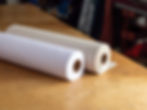Choosing The Right Interfacing For Your Project
- WAWAK Sewing Supplies
- Jan 9, 2023
- 4 min read
Updated: May 28
Interfacing is used in everything from garment to upholstery sewing and everything in between—meaning there are a lot of different styles of interfacing. So how do you know which one to use? In this post, we’ll walk you through everything you need to know to choose the best interfacing for your next project. Let’s get started!

WHAT IS INTERFACING IN SEWING?
Interfacing is a material that’s applied to the wrong side of a fabric to reinforce it and add strength and stability. Anytime you want to make a piece of fabric stronger, more stable, more structured, or add a bit more body—that's what interfacing is used for. You’ve probably seen interfacing used on the inside of shirt cuffs or collars, but it’s also essential for projects like bags, quilts, apparel, crafts, and many more.
Fusible Vs. Sew-In Interfacing
Interfacings come in two main styles: Fusible and Sew-In. Regardless of their material or construction, most interfacings can be one of the two. Fusible Interfacing features an adhesive backing that allows you to iron the interfacing directly onto the fabric for a permanent bond. Sew-In Interfacing (also known as Non-Fusible Interfacing) has no adhesive and can be sewn in place like any fabric layer. Which is best for your project? Here are a few factors to consider:
1. Fabric Heat Tolerance
Not all fabrics are safe to iron. For delicate, textured, and heat-intolerant fabrics, you’ll want to stick with Non-Fusible Interfacing to avoid potentially damaging your fabric with an iron.
2. Fabric Drape
Because of its adhesive backing, Fusible Interfacing tends to have a slightly stiffer look and feel than Non-Fusible Interfacing. Non-Fusible Interfacing is ideal for creating a more natural drape of the fabric, whereas Fusible Interfacing can add a bit more structure.
3. Time and Convenience
Fusible Interfacing is a big time-saver for many sewers and is super convenient to use—you can even attach your interfacing to a length of fabric before cutting out pattern pieces to reduce the amount of cutting you have to do!
Choosing an Interfacing Type
Like fabric, interfacing can be made of different materials and woven or constructed in different ways that will affect how you work with it. Most interfacings for sewing fall into three major types: Woven, Non-Woven, or Knit.
Woven Interfacing
Woven Interfacing is very similar in look and feel to a woven fabric. It has a grain, so it is important to match the grain to that of your fabric when applying it. You’ll also have to cut along the grainline, as you would with woven fabric. Many sewers choose Woven Interfacing for woven fabrics (especially delicate fabrics like silk) because it adds body without losing the natural drape and movement of the fabric.
Non-Woven Interfacing
Non-Woven Interfacing has no grain and can be cut and applied in any direction. This makes it easier to work with and can help save material, though it tends to be less stable after washing than Woven Interfacing. It has a slightly stiffer look and feel, making it a popular choice for bag making and crafting.
Knit Interfacing
Knit Interfacing (also known as Tricot Interfacing) is made of a knitted material that allows it to stretch. It’s great for adding stability to knit fabrics or stretch materials like jersey while maintaining the fabric's stretch. Like Woven Interfacing, it also has a grainline.
How To Choose Interfacing Weight & Color
Once you’ve decided on the interfacing you want to use, you’ll have to select the weight, or thickness, of your interfacing. This part is easy: you want to choose an interfacing that’s the same weight as your fabric or slightly lighter for the most natural fabric appearance. WAWAK offers a variety of interfacing weights so you can find the best match for your fabric:
Choosing an interfacing color is a similar process: try to find what suits your fabric the best. Interfacings are usually only available in basic colors like black, white, grey, and tan, so you’ll want to choose whatever is closest (black for dark fabrics, white for light fabrics, etc.).
Which Interfacing Width Is Best?
Interfacing Rolls are also available in several widths—just choose the width that is best suited to your project needs!
For reinforcing cuffs, hems, sleeves, seam edges, and elastic casings, these ½” - 4” wide Narrow Interfacing Rolls are a great fit.
Working with waistbands? These 7/8” - 3" wide Waistband Interfacing Rolls are perfect for preventing waistbands from rolling.
Cut interfacing to your desired size with Interfacing Rolls that measure up to 74 inches in width. Great for backing larger areas or pattern pieces, quilt batting, and more.
Specialty Interfacings
WAWAK also offers a variety of specialty interfacings for crafting, quilting embroidery, and more. Some other types of interfacing you might encounter include:
Fleece Batting/Interfacing: Soft non-woven interfacings with higher loft, great for quilts, stuffed animals, and soft craft projects.
Embroidery Stabilizer: Includes backing to stabilize embroidery work and removable material for transferring designs.
Hair Canvas Interfacing & Weft Interfacing: Two types of crisp woven interfacing used in suit tailoring.
Muslin: Sturdy material used for draping and pattern making that can be used as interfacing.
Paper-Backed Adhesive: Adhesive sheets for bonding fabrics together.
INTERFACING CHART
Looking for a place to start? Our handy chart can help! Find your project type on the lefthand side of the chart to see our recommendations for the best interfacings that might work for your project. If you're ready to start browsing, feel free to check out our full selection of interfacings at WAWAK. And if you still have any questions about interfacings or any of WAWAK’s products, feel free to contact our team—we're always happy to help.
Use this handy chart to help determine what type of interfacing works best for your project.






